Disclosure: Meeple Mountain received a free copy of this product in exchange for an honest, unbiased review. This review is not intended to be an endorsement.
When I picked up a copy of Evacuation (2023, Delicious Games) at SPIEL 2023, I had to admit—the thing didn’t look that special.
However, I am a sucker for anything with a big spaceship on the cover, so it had that going for it…and, designer Vladimír Suchý has made a couple games that I’m fond of, including Underwater Cities and the very good Pulsar 2849. Since Suchý crushed it with Pulsar 2849, I figured, hey, the guy seems to like complex space games, right?
On the strength of the review from our friends at ThinkerThemer, I got my copy of Evacuation to the table in recent weeks. Much like the tagline for the old game Mastermind—”Easy to Learn, Difficult to Master”—Evacuation is a straightforward teach, a game that could be taught in about 20 minutes.
But the consequences of the actions across the game’s tight playtime? This is the heaviest Suchý design I’ve played. (BGG seems to agree.)
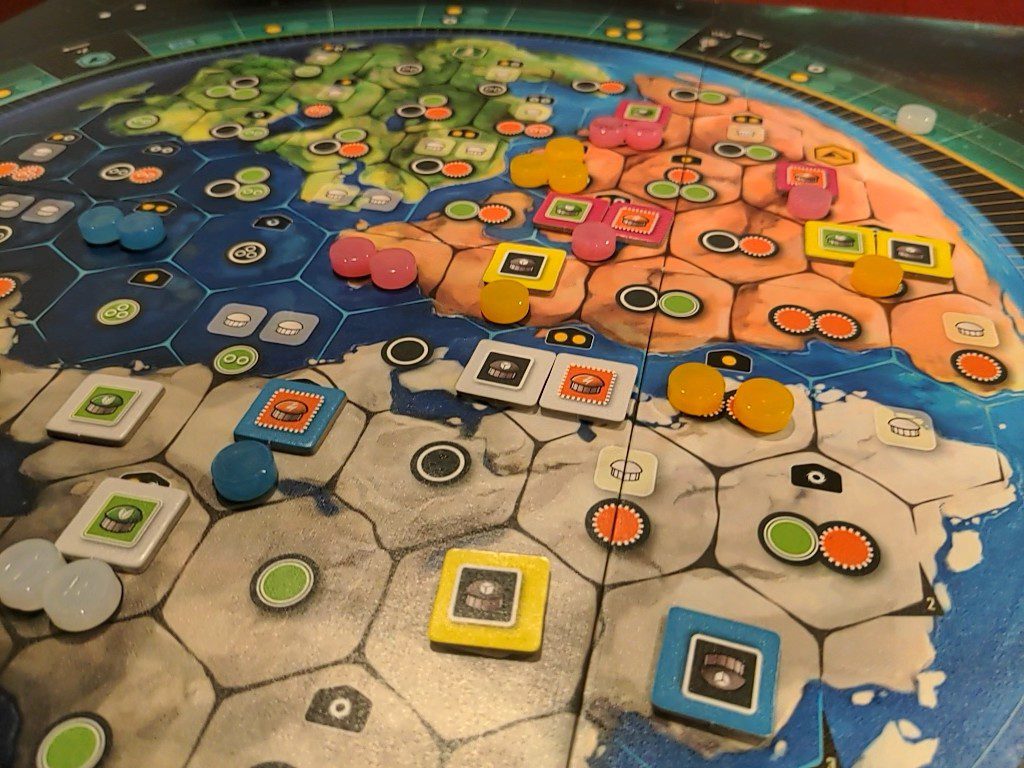
The World is On Fire (Again)
Evacuation’s approach is straightforward. Our planet is in ruins thanks to rising temperatures, so we’ve got to get everyone off this rock and onto a more habitable planet, stat. (The rulebook’s version of events is much better than that, even amusing at times. Still, this theme doesn’t feel that original.)
Players take on factions racing to get their people off the planet. Over the course of a maximum four years (rounds), you’ll have to take actions to rush people onto spaceships, develop technology that can be used on both the old world and the new one, and…build stadiums?
Yes, Evacuation simplifies the needs of people down to just three resources (food, energy, and steel) and to one metric regarding community satisfaction: happy faces. Yes, happy faces. Happy faces are delivered in the form of stadiums, stadiums that provide entertainment to the people while trying to not get burned to a crisp on the old world, or surviving in a frozen tundra on the new one.
The happy faces thing reminds me of Through the Ages: A New Story of Civilization in that way, for those who know the Czech Games Edition classic. Keep happiness in check, and you will do great things for your people. That, and you get to go first in turn order if you have the happiest people. One other thing—stadiums can be loaded onto your spaceships, along with your population and your production factories on the old world.
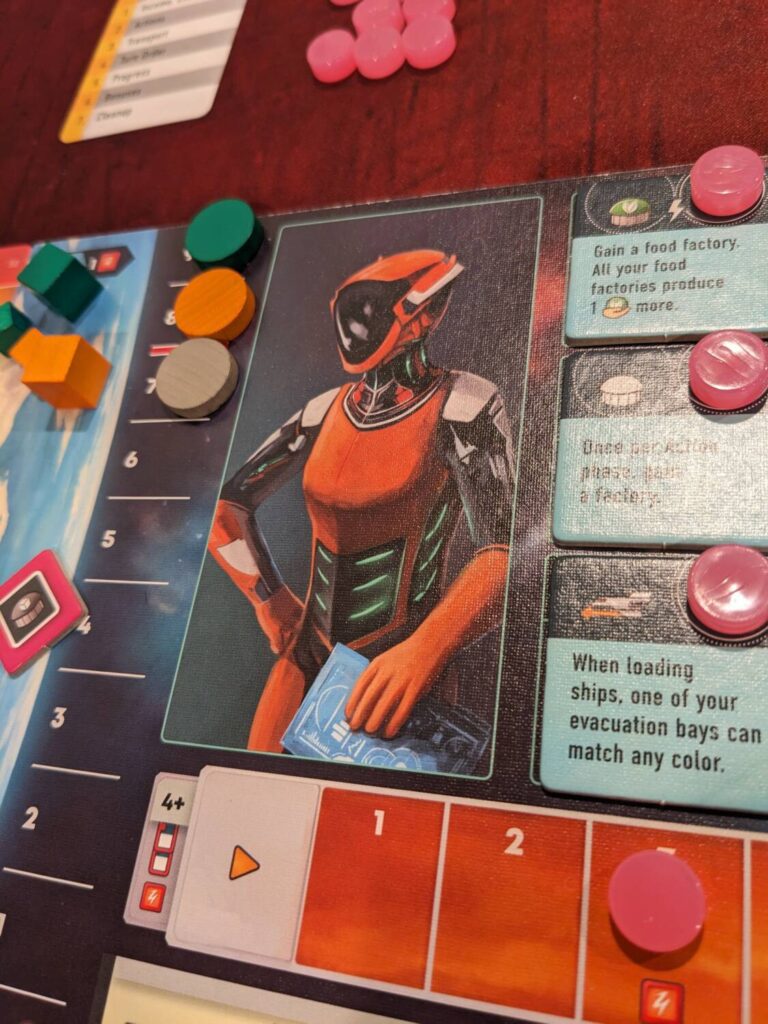
I have GOT to get my hands on this future!! I keep imagining a scenario where someone trucks Yankee Stadium into a massive spaceship loading bay.
Anyway, Evacuation uses an action point system to navigate each round. In the game’s basic mode—Race Mode, the recommended play type by both the designer and this reviewer—players will take a single action on their turn. They could develop technology from a 3×3 grid of very cool upgrades that make actions better or provide one-time bonuses. They could clone citizens on the new world, providing ways to upgrade production across the three resources. Infrastructure cards can be acquired then played to boost production as well, assuming players settle hex tiles on the new world that meet each card’s requirements.
Getting people off the old world feels on point. The action point system provides a nice limitation, particularly when paired against another system that requires an increasing payment of energy for every action after the second one. In each of my plays (two solo, one three-player game, and one four-player game), I found myself strangled by this action point system, in a good way. I want to take a fifth action, but can I really afford to pay three energy to do something else?
But I think what makes Evacuation sing are two other elements: the resource management and the Progress Track.

Evolution
To begin the game, all of a player’s production comes from the regions on the map of the old world (the one you are trying to evacuate). That is exactly seven of each resource when play begins.
Then, you have to feed your people. That eats up five of the seven food cubes in the first round. Each year, this changes a bit—in year two, you don’t need any food for the population on the new world (even if you have any, which you likely will not), but the old world folks still want four of those valuable food cubes. In year three, you need two food in both the old and new world, and in year four, you need four food for the new world and one for the old.
You also need to do things like build ships in the old world, and clone citizens in the new world. You’ll need stadiums in the new world (remember, you can take Yankee Stadium with you), but those stadiums can also be built in the old world. “Pre-fabricated” factories can be built in the new world, but you could evacuate those from your old world sites and then settle those on regions of the old world later.
This is where the complexities really shine in Evacuation. Managing your stuff on both worlds—represented by the left and right side of your player board—is a real challenge. Then, Suchý made it a little harder because of something I haven’t mentioned yet: the Progress Track. To make things more interesting, you have to advance on a track that weaves through the middle of the board with two satellites. These satellites will move forward and pass through transition spaces that grant players the ability to settle in better parts of the new world.
BUT! Those satellites also dictate something else: from where on your player board you can spend energy to take your actions. When both satellites are in the first half of the Progress Track, you must spend energy from the old world to take actions 3+ in a round. When one of the satellites passes the middle of the Progress Track, you can spend energy from anywhere to take actions. When both are on the second half of the track, you have to spend from the new world only.
Not planning for these changes? Brutal. Not getting your production up on the new world? Also brutal. That can happen when you drag your feet evacuating production from the old world and not setting it back up in the new world, another consideration. Fail to play into your tech tree? That could lead to multiple setbacks too!
But over the course of my four plays, this got a little smoother each time. And attacking this puzzle as a race, and not a points challenge, made things much more interesting for me…I have to figure out how to get all of these souls to the new world, while upping my production engine there to 8+ resources for each of the three resources in play, to trigger the end game before another player can beat me to it. How?
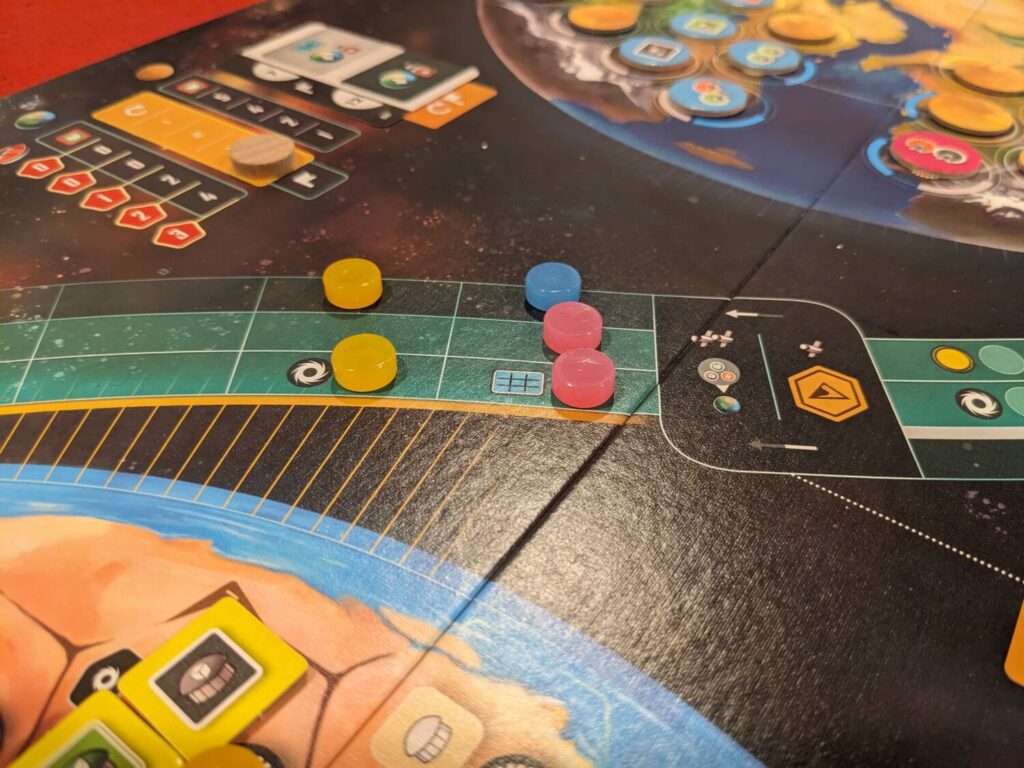
Elastic
Evacuation’s focus is really tight. In race mode, there aren’t five ways to win. You’ve gotta boost production everywhere, and ideally get everyone off the old world. (The game is called Evacuation.)
I like this focus quite a bit, and certainly more than the point salad approach of Pulsar 2849. (It’s a tasty salad, but a salad nevertheless; when players regularly score 170 points and there’s no tiebreaker, you know it’s a salad.) Even better—the game will probably end before the end of the fourth year in Race Mode. The best player is going to win. No hidden milestones. You can see everything coming. And it’s usually going to be over in about two hours, maybe a little less.
Now, if you want to play Evacuation like a Euro with some of those Euro-y elements, you certainly can! In fact, as much as I love the base game here, I love that there are maybe six mini expansions included in the box. You can play the game in Points Mode; solo play is only available as Points Mode.
You could add public milestones, private goals, and advanced action variants to spice up turn-to-turn actions. Heck, this game even changes the end-of-round bonus structure to be targeted or generous, by allowing players who miss the target of aligning their action points to still get something for their efforts, leaning into salad territory of giving everyone something just for sitting at the table.
You could make Evacuation super heavy. You could tailor it to your friends who like a mid-weight points extravaganza. And you could stick with a very solid base game with production that really works—the board looks great and isn’t complicated, the Progress Track adds something special, the tech tree is great (albeit limited, with only four sets that are randomly distributed during setup).
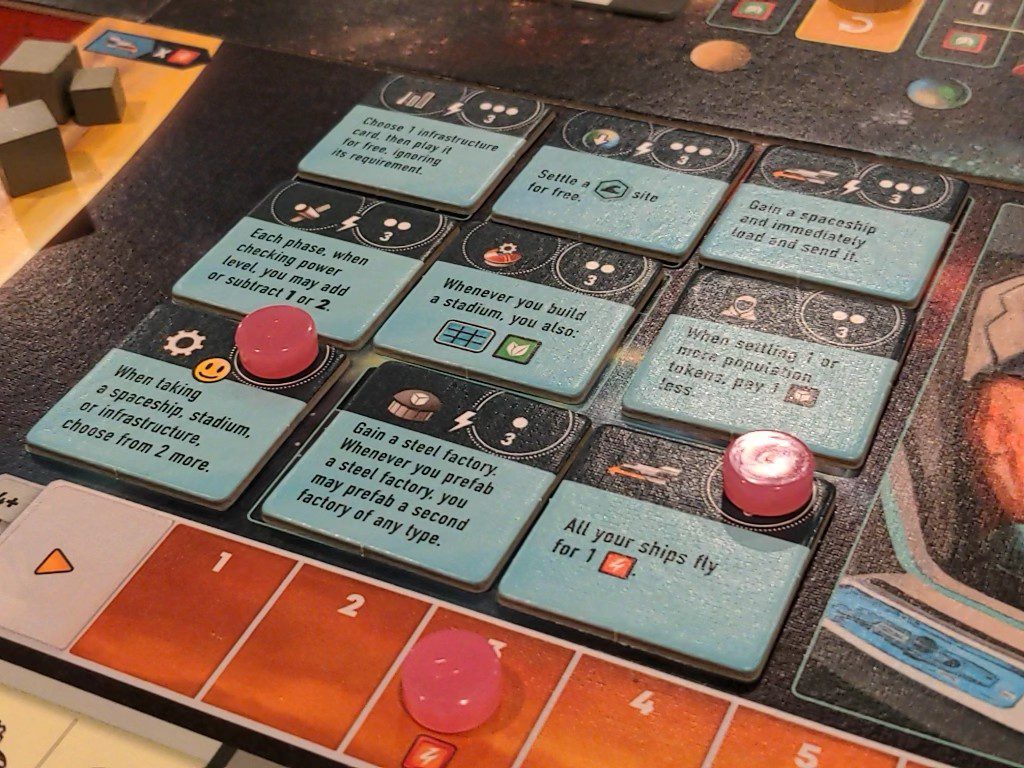
What are the downsides? The main one is what we’ll call “The Kutná Hora Problem.” I think Evacuation is best at four players—you could probably push me into saying that Evacuation is a four-player-only game, because it doesn’t have a double-sided board that scales to player count.
Also, Evacuation is so tightly focused that it might not excite a group beyond a fifth or sixth play. That’s fine; some games are simply built to be excellent across 3-5 plays, before things diminish with a knowledge of what likely works well enough to win regularly.
I wish there was more variety in the tech tree, but I do like this tree and some of the top-tier bonuses feel broken. That’s a good thing; you want players saying something like “that’s crazy broken” before pulling off their own crazy broken one-time bonus that swings the game into someone else’s favor.
The new world map is the same regardless of player count, meaning that with two players, there’s a ton of space in the new world to build almost anywhere you want. At four players, things get tight fast, particularly when players get access to the better parts of the new world (the desert, forest, and water regions). This difference significantly boosts my interest in playing Evacuation at the full player count.
Evacuation is a big surprise. As it turned out, it was the only game I bought at SPIEL, and it turned out to be one of the better Euros I played this year. I am already looking forward to expansion content…Evacuation is now my favorite of Suchý’s designs.


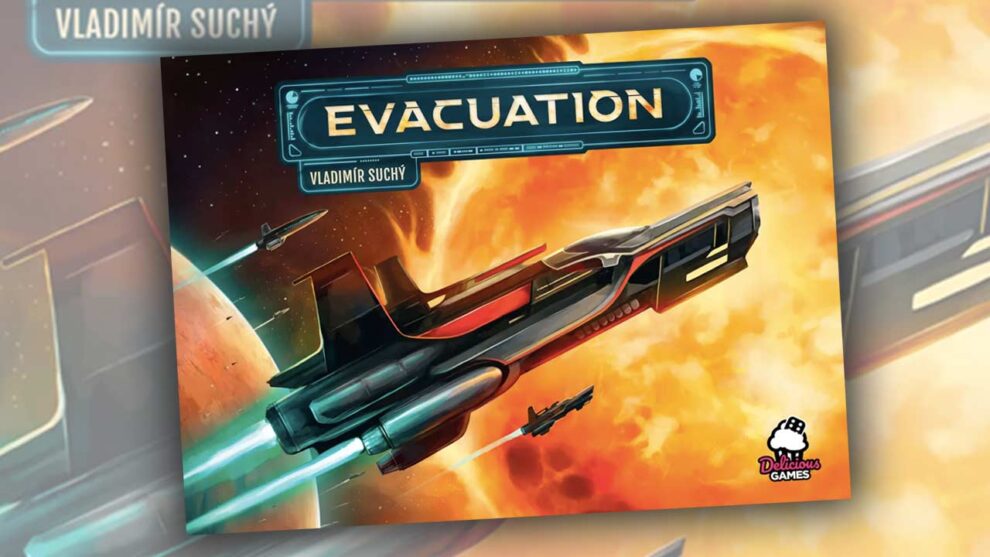









Add Comment